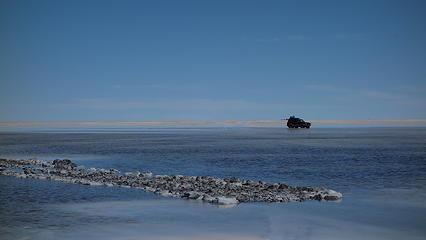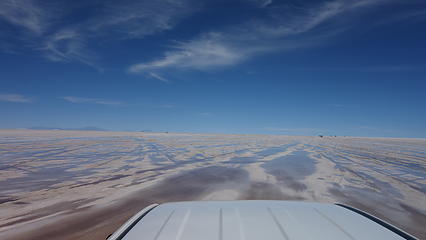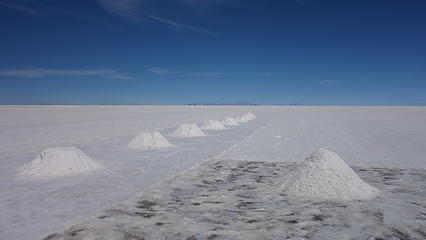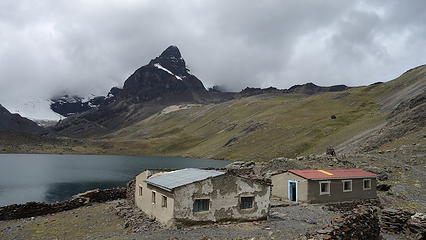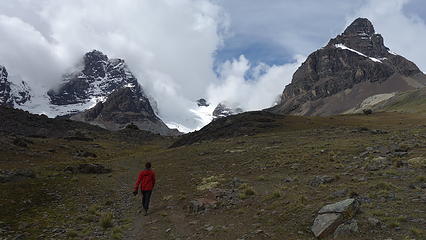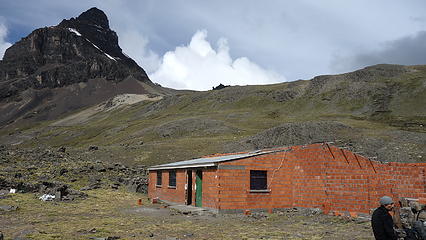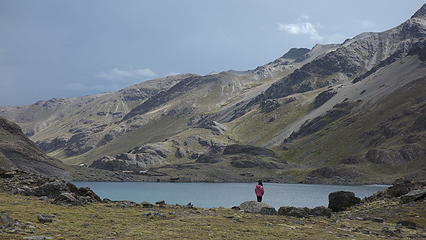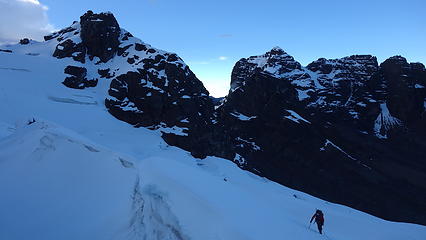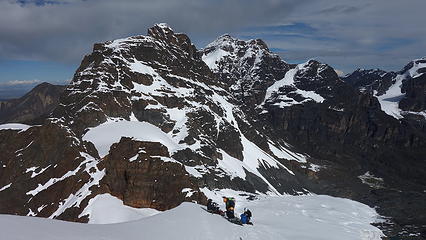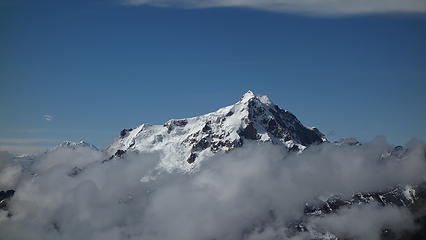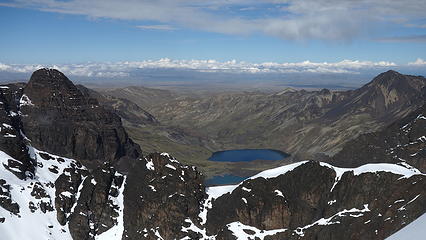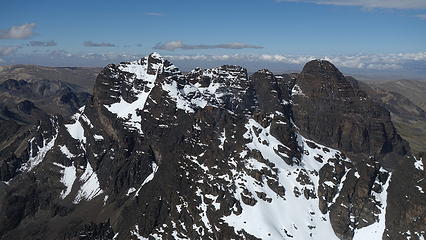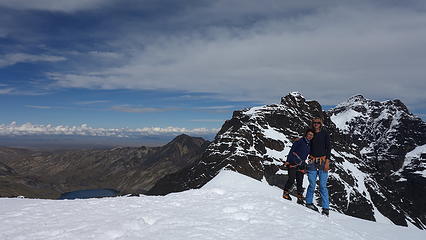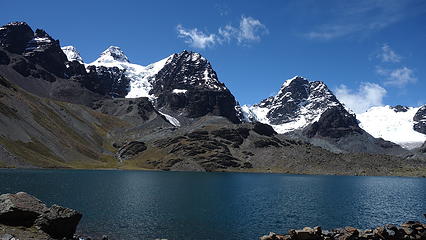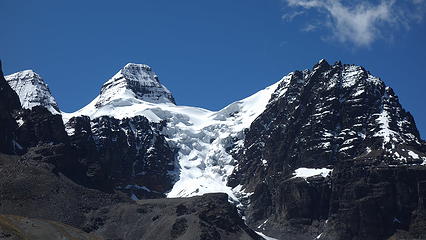pequenyo alpamayo - 17618' - sw ridge class 4 / ai 2
april 2018
Continuing on in South America from last spring, the two of us went on yet another long bus ride to the border town of La Quiaca in extreme northern Arizona after climbing Nevado de Acay in the Puna de Atacama region of northern Argentina. It was in this town that for some reason my bank card stopped working, and I had to go to a cafe with wifi and call my bank using Skype and try to resolve the issue so I could withdraw a bunch of Argentine Pesos. I knew I would have to pay USD$160 to get a Bolivian tourist visa as an American citizen. Eventually I was able to get it working and sucessfully got money from the ATM. Elaine and I had met up with a couple from Germany and England who travelled with us as we crossed the border into Villazon. Getting my visa for the most part was painless, however I had to leave my passport with the Bolivian officer while I went next door to the casa de cambio to exchange my Argentine pesos for US dollars (thank god they had some), and pay my 160 dollar fee. Once I got my visa approved, the 4 of us got some food, and took a taxi to the central station.
Villazon was actually a bustling, and much larger town than I expected. Great food, a lively atmosphere and filled with travelers. I can only imagine this town isn't typically what Bolivians are used to. We boarded a bus heading north to Tupiza. Our plan was more or less going to follow the typical tourist track through western Bolivia, staying high in elevation and hitting up all the main attractions, such as the Uyuni salt flats before arriving in the capitol city of La Paz, where we would spend a few weeks and climb in the Cordillera Real.
We arrived in Tupiza late in the evening, and managed to find a bed and breakfast type place for us to stay the night. We decided to continue to Uyuni the next day and once there (another 6+ hour bus ride) and rather than join an overpriced excursion to the salt flats we simply took a taxi from Uyuni to Colchani, a small town 15 minutes north where most parties access the salt flats from. We explored the nice museum at the edge of the salt flat which was actually very informative, and hitchhiked onto the salt flat catching a ride with a nice Russian couple who had a pickup. They took us as far as the salt hotel a few miles onto the flats where we could really experience the vastness of the landscape. The Uyuni salt flats are the largest in the world, over 4 times bigger than the Salt flats west of Salt Lake City. The landscape seemed to go on forever. We played around with some crazy perspective photos, but since water on the flats had only very recently dried up, the surface wasn't as flat as it could be. There were salt crystals making the salt surface very undulating.
The lighting for photography was also harsh, with the sun at midday high, the brightness was overwhelming and without sunglasses, snow blindness was certain. The temperatures were pleasant though since the elevation was so high (over 4000 meters).
We weren't successful getting a ride back out that afternoon, so we had to walk the entire way back to Colchani, and through town back to the main Highway 30 and wait for a bus heading back to Uyuni. Luckily, in speaking with a few of the locals they told us one would come by around 4:30. Amazingly we got back to our hostel with daylight to spare. The next day we continued north on the night train to Oruro, which was interesting, however very slow and fairly noisy. The beautiful views we had at sunrise the next morning though were incredible, as there were expansive swamps and ponds with thousands of pink flamingos flying all around. When we arrived in Oruro, we didn't stay in this grungy town more than a few hours and got on a late morning bus to La Paz, which we arrived in mid afternoon. As we got closer on the bus, the Cordillera Real came into view and our excitement began to grow. Since it had been nearly a week since we had climbed anything at this point we were itching to get back into the mountains.
I will never forget first coming into La Paz though...we spent over 30 minutes driving through what I thought was La Paz, but was only the suburb of El Alto. Right when we reached the rim of the bowl where the main city of La Paz sits, and looking down, I realized just how expansive La Paz was, and was just blown away how many people live in such a high and challenging place. When I noticed one of the many gondolas around the city I was told they are one of the primary methods of public transportation in the city! I was amazed. We explored around the heart of La Paz starting from where the bus dropped us off at the Estacion Central on the NW portion of the bowl. It was suggested we go to Av Sagarnaga where we could find other climbers, agencies and good hostels. We decided to stay at a lovely, quiet hostal at the intersection of Av Sagarnaga and Av Illampu just a short walk away from anything we needed.
We checked around at a few different agencies inquiring about costs for just a ride to the trailhead for Pequenyo Alpamayo. To my surprise, prices varied considerably but after we started chatting with one agency, and getting some conditions reports from a couple of their guides, we decided to utilize their service since they were so helpful. We agreed to leave the next morning. It was amazing how long it took us to get out of La Paz (well over an hour to go a few miles), back on the Altiplano above the bowl, then another hour to get through El Alto. Traffic in La Paz is legendary, and there are no rules on the road! As we got closer to the mountains, the pavement ended and we continued up past the foothills, then into a beautiful valley filled with Alpaca, Llama, green grass, and blue tarns. Pequenyo Alpamayo itself sits in the group of peaks called the Condoriri, because when viewed from the Chiar Khota lake, and the Refugio Condoriri the peaks make a profile that looks like a flying condor. The hike to the lake only took an hour and a half, so we didn't bother hiring mules. At 4600 meters, the lake is a great place to acclimate, however since we had already been acclimating for nearly a month at this point, it was an easy walk to get there.
As we were climbing unguided and independently, we stayed in one of the small huts at the south end of the lake, which only cost a few dollars per night which we happily gave to the owners of the place. It wasn't much more than a couple rooms with hay bags for a soft place to sleep. We laid out the hay bags and threw our sleeping bags down upon arrival to the hut and chatted with another party who was headed to the refugio on the opposite end of the lake where the guides typically bring clients. The view from our little perch was gorgeous as the afternoon glow lit up the mountains above, which were still clad in snow and ice. Off to the right, there is a dark colored tower called Aguja Negra, which has decent adventurous rock climbing on it that the guides in La Paz told me about. It would have been awesome to try them out, but the weather wasn't too conducive for rock climbing.
We got an early start, leaving our room well before twilight. We hiked back around to the north end of the lake and passed the refugio. We noticed headlights from the guided party nearly reaching the toe of the glacier about a mile ahead of us. We continued up the valley following a good trail, slowly catching up to them. When we reached the glacier, we donned out mountaineering boots, and left our approach shoes at the edge of the ice and took a good break to eat. It was still dark, however shortly after we got in a good rhythm on the glacier we started to see some twilight. We made an ascending traverse leftward up the glacier towards the saddle between the right wing of the condor, and the false summit of Pequenyo Alpamayo known as Tarija. Just as we reached this saddle, a fast moving snowstorm engulfed us into a whiteout, and we took shelter in a small snow cove shortly below the summit of Tarija. After waiting out the storm for 45 minutes, we heard the guided party on the upper ridge not far from us, so we decided to continue in hopes the storm would pass.
Just as we crested the summit of Tarija, and started descending the class 3 rock on the opposite side, the clouds began to part. We traversed the glacier clad ridge, weaving around large crevasses more or less following the footprints from the guided party just ahead of us. Once we reached the low point on the ridge between Tarija, we climbed a short 55 degree slope on the exposed ridge to a nice small flat perch 100 feet below the summit where we crossed paths with the guided group on their way down. The final little bit of the climb involved some steep class 4 rock covered in snow. When we reached the summit the weather had completely cleared!
We enjoyed our first Cordillera Real summit and were so amazed how much the weather improved just as quickly as it turned earlier. On the descent, we were able to comfortable downclimb the class 4 snow covered rock just below the summit, and traversed safely back to Tarija, and had an uneventful descent back to the lake, where we were able to chat a bit more with the guided party. They were fairly amazed at our speed. Upon packing up and hiking back to the trailhead, where our pre-arranged ride will be there at 4pm to pick us up, we got back early and had to wait for 3 hours in the meadow! A group of Israelis joined us and was in need of a ride so we allowed them to join in with us, since we would have an entire van for just Elaine and I. Our first of three planned climbs we intended to do in Bolivia was a success, and we were excited already for the next one, where we were hoping to climb the French route on Huayna Potosi.



